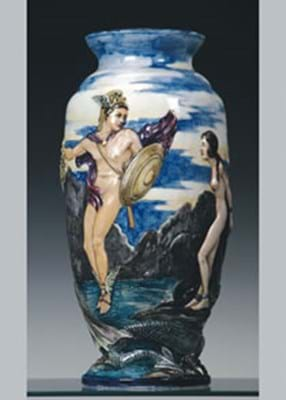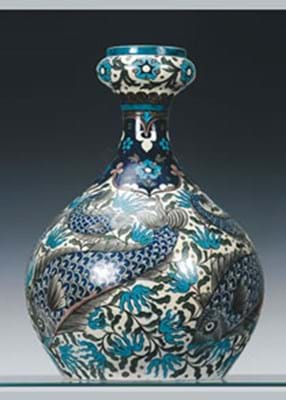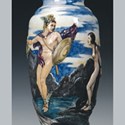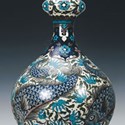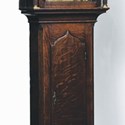Perhaps as few as four of these quite atypical factory productions were made and most collectors only know them from the vase long on loan to the Laing Art Gallery in Newcastle and a pair pictured in R.C. Bell's 1971 book Tyneside Pottery.
But they do occasionally appear on the market. The pair pictured in Tyneside Pottery was sold in the mid 1990s at Anderson & Garland's former salerooms in Marlborough Crescent, Newcastle at £5100, then a record for the factory.
A decade later, the owner of the vase in the Laing chose to consign it for sale at A&G's new saleroom in the Newcastle suburb of Westerhope where it was estimated sensibly at £2000-3000. It was competed to £4400, selling to a collector from the North East.
While Maling remains a predominantly locally-based collecting field, the best productions of the Burmantofts factory are admired well beyond the confines of their native Yorkshire. As mentioned in last week's report of the Decorative Arts sale at Lyon & Turnbull, the Edinburgh auctioneers had achieved a substantial £11,000 (plus 15 per cent premium) for a massive 21in (53cm) high vase decorated in the Anglo-Persian style with fish on blue ground by the artist known only from his monogram LK.
In recent years, this has somehow become accepted as a reference to one Louis Kramer, but new research conducted by Dr Scott Anderson has suggested the much less exotic Leonard King as a likely candidate for some skilful and stylish decoration.
A vase of the same size, form and subject matter was offered in Westerhope carrying, incidentally, the same estimate of £3000-5000. It had been found by Jack Dudgeon, former Borders auctioneer turned A&G representative, in a home in north Northumberland area.
It was marginally more sophisticated, in terms of its border and background decoration, than the Edinburgh example and was also considered a better firing with little of the 'orange peel' that can occur on pieces of this scale. Underbid by the Scottish dealer who had purchased the vase two weeks previously, this one sold to a dealer from the South at £13,000.
A fine Wedgwood Fairyland lustre Imperial shape bowl decorated in the Woodland Bridge pattern with mermaid centre, 10in (25cm) diameter, sold more as expected at £2100 to a private British buyer.
Performing well above expectations in the silver and vertu section, was a 19th century, tortoiseshell-covered, singing bird box. The enamelled hinged cover was decorated to the exterior with a landscape with a lake and to the interior decorated a bouquet of flowers. Well undercooked at £250-350, it made £2200.
Another predictable favourite was a fine and impressive Edwardian cast of the twin-handled campana-form Warwick Vase with its iconic decoration of bearded masks, fruiting vines, and acanthus motifs. Standing 91/2in (24cm) high, weighing close to 93oz and marked for the London silversmith H, Wilkinson & Co., 1909, it sold at £5800 (estimate £3000-4000).
A strong £4300 (estimate £1000-1500) was bid for a Cumbrian-made 18th century oak longcase. It was rather stout in appearance, standing 6ft 10in (2.08m) high with a hood some 19in (47cm) across, but incorporated a 13in (33cm) arched brass dial inscribed Joshua Harrocks, Emont-Bridge with a painted rolling moon phase above.
Harrocks is listed in Brian Loomes' Clockmakers of Northern England as working first as a journeyman alongside the Lancaster clockmaker Robert Parkinson (who produced some very fine clocks using cases made by Gillows) and then on his own in the tiny settlement of Emont-Bridge, near Penrith from c.1764-1783.
The connection to a very rare and early maker from the north Lakes, an area now so popular with period-furnishers and second homers, helped in the price.
The furniture proper was more routine, as were the prices it realised. However, helped by some modest estimates and the occasional input of free-spending private buyers, there was a stronger take-up than has become the norm.
Two pieces shared the top bid of £3200.
Measuring 4ft 8in (1.42m) diameter was a fine-quality, and very Scottish, Regency period, rosewood breakfast table. Its gadrooned tip-up-top was raised upon an ornate carved thistle pattern column and triform legs embellished with foliate roundels and terminating in large lion paw feet. Another nice find for Jack Dudgeon in the Berwick-upon-Tweed area, the estimate was £2500-3500.
The same amount was bid on a pair of Victorian burr walnut and part ebonized cabinets, each 3ft 11in (1.19m) wide by 3ft 6in (1.07m) high and embellished with pierced brass galleries and a fluted and parcel-gilt pilaster either side of a pair of glass panelled doors.
Not an easy sell in the current market but, with more light than black wood on show and some nice features, the cabinets pushed on past their estimate of £2000-3000. Picture highlights from this sale were reported in last week's issue.
Local gallery’s loss is Maling collector’s rare gain at £4400
AMONG the great grails of Maling collecting are the so-called Urbino style vases: 16in (41cm) high exhibition pieces c.1945 decorated in relief with a celebrated moment from classical mythology by Lucien Boullemeir to a design by Norman Carling. The scene shows Perseus holding aloft the Medusa’s head to petrify the sea monster and save the beautiful Andromeda, who is chained to the rocky shore.

